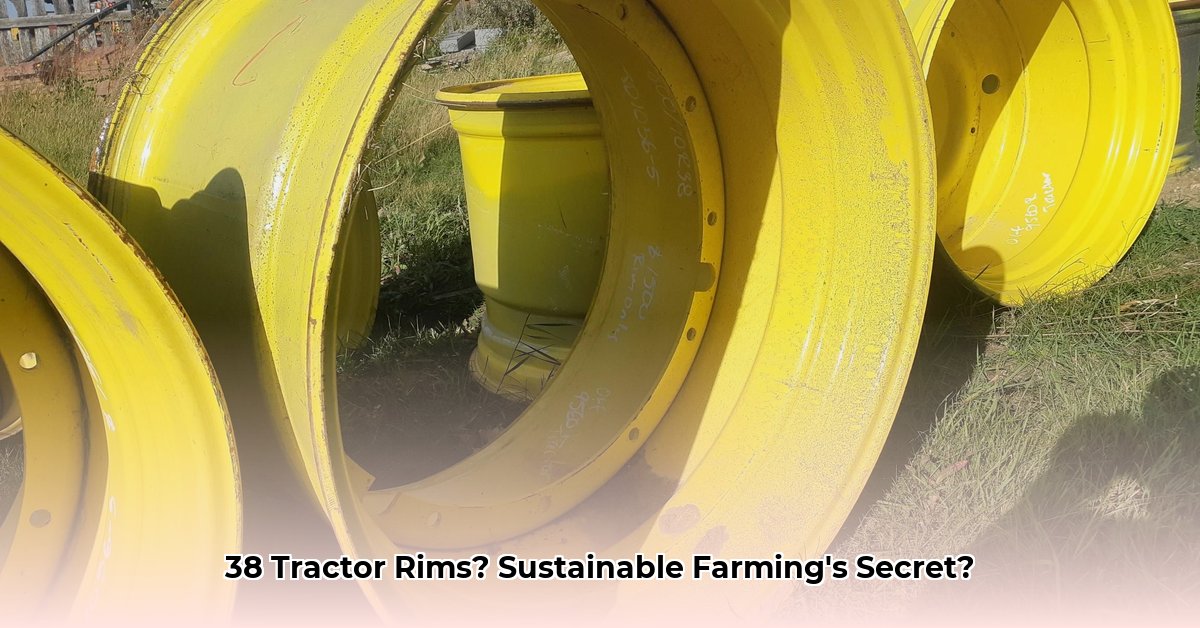
Imagine Jed, a third-generation farmer in Iowa, staring out at his sprawling cornfields. His yields are good, but he’s feeling the pressure. Competition is fierce, and labor costs are rising. He's considering a major upgrade: a new tractor, boasting impressive 38-inch rims. This seemingly simple decision, however, carries significant weight, touching on efficiency, sustainability, and the very future of his farm. This isn't just about bigger machinery; it's about navigating a complex interplay of economic realities and environmental responsibilities. This article explores the multifaceted implications of adopting 38-inch tractor rims, offering insights for farmers and policymakers alike. For more on tractor tire sizes, check out this helpful resource: tractor tire sizes.
38" Tractor Rims: Weighing the Pros and Cons for Sustainable Farming
The allure of larger tractors with 38-inch rims is undeniable. Larger machines typically translate to increased efficiency, covering more ground in less time. This leads to faster planting, harvesting, and overall farm operations, potentially reducing labor costs and boosting productivity. Larger tractors often accommodate larger implements, further enhancing efficiency. But this seemingly straightforward advantage masks a complex reality. The increased efficiency comes at a cost – a potentially significant one.
The Environmental Footprint: Soil Compaction and Beyond
While larger tractors may reduce emissions per acre due to increased efficiency, the reality is more nuanced. The larger size and weight significantly increase ground pressure, leading to soil compaction. This compaction inhibits water infiltration, restricts root growth, and increases erosion – undermining soil health, a critical component of sustainable farming. Is the increased efficiency worth the risk to long-term soil fertility? "The long-term impacts of soil compaction can severely impact crop yields for years to come," explains Dr. Emily Carter, Soil Scientist at Cornell University.
Furthermore, larger tractors typically consume more fuel, negating some of the emissions benefits. The manufacture and eventual disposal of these machines also contribute to the overall environmental footprint. Recent research highlights the need for comprehensive life-cycle assessments (LCAs) to accurately evaluate the true environmental cost of these machines. These LCAs should not only consider fuel consumption but also manufacturing processes, material sourcing, and ultimate disposal.
Mitigating the Negative Impacts: Sustainable Practices in Action
The good news is that many sustainable farming practices can help mitigate the negative environmental impacts of larger tractors and 38-inch rims. These aren't simply add-ons; they are integral to maximizing the benefits while minimizing the risks.
- Precision Farming: GPS-guided machinery allows for precise application of inputs like fertilizers and pesticides, minimizing waste and environmental damage. This targeted approach reduces the overall impact, offsetting some of the negative aspects of larger machinery.
- Controlled Traffic Farming (CTF): This technique involves carefully planning tractor routes, using the same tracks repeatedly. This strategy significantly reduces soil compaction by concentrating the impact on a smaller area.
- Reduced Tire Pressure: Utilizing advanced tire technologies like IF (Improved Flexion) and VF (Very High Flexion) tires, and employing Central Tire Inflation Systems (CTIS), allows for adjusted tire pressure depending on field conditions, significantly reducing ground pressure.
- No-Till Farming and Cover Cropping: These practices improve soil structure and health, enhancing the soil's resilience to compaction.
Actionable Steps: A Pathway to Sustainable Implementation
- Conduct a thorough cost-benefit analysis: Carefully weigh the initial investment against projected increases in efficiency and potential long-term costs related to soil health and fuel consumption.
- Invest in advanced tire technology: Explore the use of IF/VF tires and consider incorporating CTIS. While the initial cost is higher, the long-term benefits in reduced compaction and increased efficiency may outweigh the expenses.
- Implement controlled traffic farming (CTF): Plan your field operations meticulously to reduce the physical impact on the soil. While requiring initial planning and potentially infrastructure investment, CTF's long-term benefits are substantial.
- Adopt sustainable soil management practices: Integrate no-till farming, cover cropping, and crop rotation into your farming practices. These techniques are crucial for maintaining soil health and resilience.
- Regularly monitor soil health: Implement soil testing and monitoring to track the impacts of your farming practices. Early detection of soil degradation allows for timely intervention.
The Future of 38" Rims and Sustainable Agriculture
The question of 38-inch rims' role in sustainable agriculture isn't easily answered. It's not a simple "yes" or "no," but rather a careful consideration of the balance between productivity and environmental stewardship. The path forward necessitates a collaborative approach involving farmers, manufacturers, researchers, and policymakers. Further research is critical, focusing on:
- Long-term soil health impacts: Further studies are needed to fully understand the long-term effects of soil compaction on yields and overall land health.
- Improved fuel efficiency: Continued innovation in engine technology is vital for minimizing the environmental impact of larger machinery.
- Sustainable manufacturing practices: The manufacturing process of tractors and their components must also be sustainable, minimizing environmental impact throughout the product lifecycle.
Jed's decision, and the choices made by farmers worldwide, will determine the future of agriculture. By embracing a holistic approach that integrates advanced technology with sustainable practices, we can harness the potential of larger machinery like 38-inch rims while safeguarding the environment and ensuring the long-term viability of farming for generations to come.